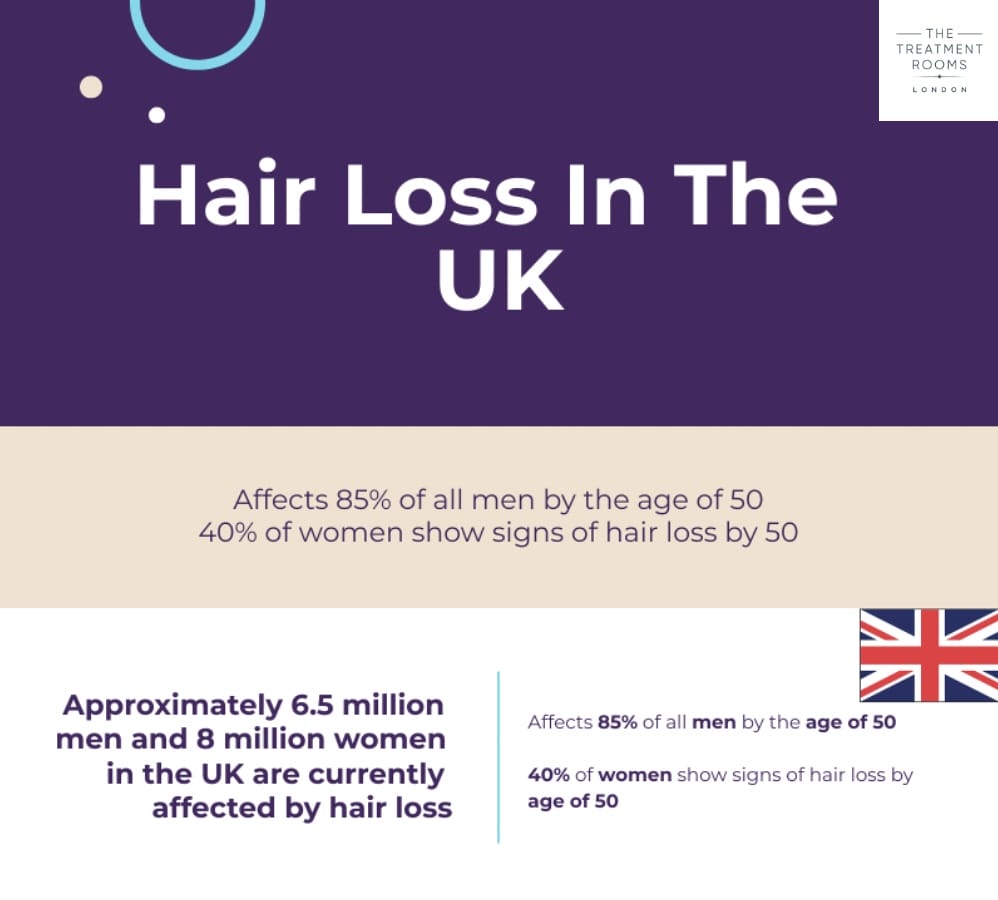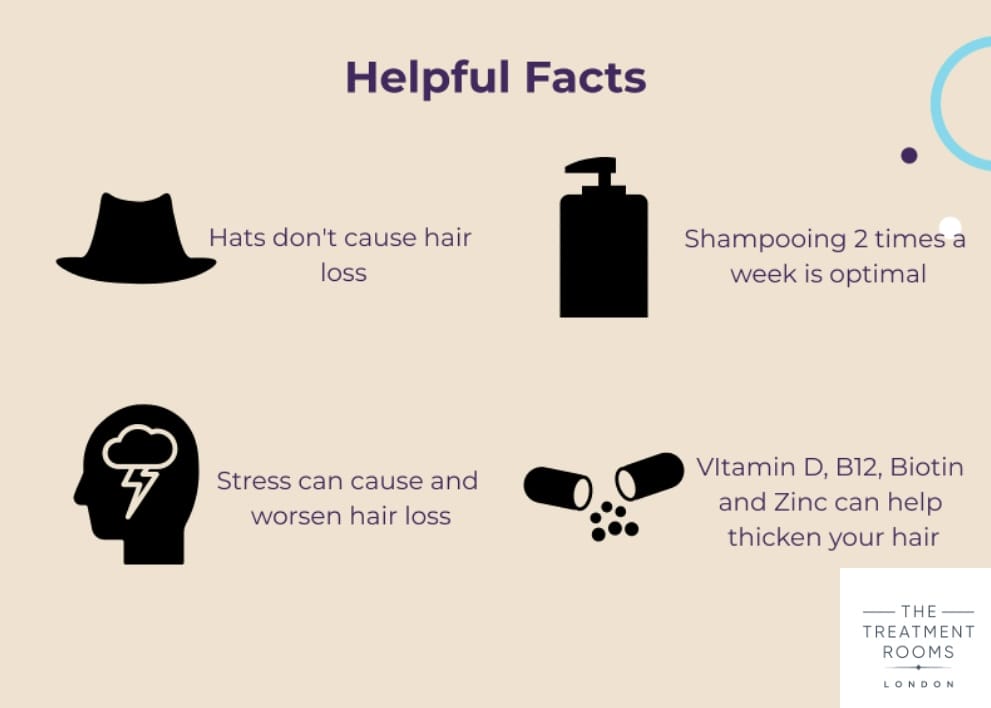Hair loss is a common concern, said to affect more than 56 million people worldwide,1 and the UK is no exception.
In this article, we delve into some relevant facts and statistics surrounding hair loss in the UK, exploring the data behind its prevalence, causes and the psychological impact it can have on individuals.
From shedding light on the differences between male and female hair loss statistics to debunking certain myths about stress, shampooing and wearing hats, we provide a detailed overview of how widespread hair loss is and what you can do about it.

How common is hair loss in the UK?
Approximately 6.5 million men and 8 million women in the UK are currently affected by hair loss.2,3
The most common cause of hair loss is androgenic alopecia or male/ female pattern hair loss which affects 85% of men by the age of 50 and 40% of women by the age of 50.
One cause behind this is alopecia areata – an immune condition known to affect 1 person out of every 500 in the UK.4
This condition causes bald patches to develop on and around the scalp, which, left untreated, can eventually cause more severe forms of hair loss, such as alopecia universalis or alopecia totalis.
However, to fully understand the prevalence of hair loss across the UK, it’s essential to look at the facts and statistics on a gender basis.
Male hair loss statistics
Male pattern baldness, known as androgenetic alopecia, is a highly prevalent condition that affects approximately 85% of all men by the age of 50.5
While typically seen in individuals during their late 20s or early 30s, this hair loss can also start at any point from 17 upwards.
The genetic nature of male pattern baldness stems from the hair follicles being sensitive and reacting to dihydrotestosterone (DHT) – a by-product of testosterone.
When this happens, high levels of DHT in the body shrink the hair follicles, shortening the hair growth cycle and causing hair loss.6 It leads to a receding hairline, thinning on the crown and temples, and complete baldness without intervention.

Female hair loss statistics
While many of the conversations around hair loss traditionally focus on men, approximately 40% of women show signs of hair loss by 50, with less than 45% of women reaching 80 with a full head of hair.7
Female pattern hair loss, a condition that causes hair to thin and fall out, is estimated to affect a third of women.8
Stress is one of the most significant contributing factors. According to some studies, women with high levels of stress are 11 times more likely to experience hair loss than women with a more relaxed outlook.9
Female hair loss has become a growing issue in the UK since the recent stresses associated with factors like the pandemic, cost-of-living crisis and social media, with almost 90% of requests for hair loss treatment now coming from women.10
Female pattern baldness is also highly prevalent in post-menopausal women. Theories suggest that reduced levels of oestrogen increase DHT’s concentration in the blood, resulting in higher levels of hair loss.
However, certain studies suggest the opposite, in that oestrogen can suppress hair growth, stating that the association between female pattern baldness and menopause must be caused by a separate factor.7

The psychological impact of hair loss
Regardless of gender, experiencing hair loss can have a substantial psychological impact on people’s self-esteem, body image and overall wellbeing.
For example, a survey by Lloyds Pharmacy found that almost half of men feel self-conscious or stressed when first experiencing hair loss.11
The survey also showed that:11
- 44% of men between 16 and 24 years were ‘worried’ about hair loss
- 35% of men felt ‘unattractive’ because of their hair loss
- 32% of men felt ‘unhappy’ with their hair loss
- 89% of respondents perceived a stigma towards hair loss
These results correspond with studies into alopecia areata that indicate patients with this condition often experience negative emotions, affecting their self-confidence.
To combat this and source a long-term solution, many people would even put their money or friends on the line to prevent hair loss.12
In a 2009 survey by the International Society of Hair Restoration Surgery, almost 60% of men would rather have a full head of hair than money or friends.13 This finding corresponds to another survey by the same organisation in which 47% of men said they would ‘spend their life savings to regain a full head of hair’.12
What causes UK hair loss?
Various factors cause hair loss in the UK. However, for many people, these are not always clear.
For example, hair loss and its various treatments are associated with several myths and misconceptions, many centred around its causes.

Hair loss: fact or fiction?
From genetics to lifestyle factors, it’s essential to separate fact from fiction by looking at specific data and statistics behind some of the most well-known ‘causes’ of hair loss. These include the following:
Shampooing causes hair loss
Contrary to popular belief, shampooing does not cause hair loss. You shed 50 to 100 hairs a day on average, mostly while washing your hair or brushing it afterwards.14
So, recognising the difference between normal hair shedding and pathological hair loss is vital.
Wearing hats causes baldness
Another misconception is that wearing hats contributes to baldness because less oxygen reaches the hair follicles. However, follicles receive oxygen from the bloodstream, not the air, so wearing hats will not affect their oxygen supply or contribute towards hair loss.
Vitamin deficiencies cause hair loss
Maintaining a healthy, well-balanced diet is crucial to reducing hair loss, as being deficient in vitamins D and B12, and biotin, zinc and iron can cause hair to thin and shed faster.15
These vitamins play a vital role in the hair growth cycle, especially during the anagen phase when the hair continues to grow.16
Without the correct levels of these nutrients, hair follicles can prematurely shift into the telogen phase, resulting in hair loss.16
Stress leads to hair loss
As highlighted earlier, stress is a significant factor in hair loss. It is particularly common in cases of telogen effluvium – a condition that stress, trauma or shock triggers and that can lead to the loss of 30–50% of hair.17
However, stress generally leads to reversible temporary hair loss. For example, stress-management techniques like meditation or regular exercise can reverse hair loss’s impact when caused by stress and lead to hair regrowth within six months.
Medications can cause hair loss
Taking certain medications can cause hair loss as a side effect.
Beta-blockers, retinoids, antidepressants and anticoagulant medications have all been associated with the onset of telogen effluvium. Meanwhile, hormone therapies like birth control pills and hormone replacement therapy can lead to female pattern baldness in women.18
If you experience hair loss while taking medication, it’s essential to consult a healthcare professional. They can identify the best solution to your needs and change your recommended dosages.
How can hair loss be treated?
A wide variety of treatment options are available to address hair loss, ranging from topical treatments to more permanent interventions. Some of the most popular options to treat hair loss include:
- Follicular unit excision (FUE) hair transplant – using this minimally invasive technique, the surgeon removes hair grafts from the back of the head as individual follicles before gently placing them into small holes in areas of thinning or no hair. This can be performed on both men and women.
- Follicular unit transplantation (FUT) hair transplant – this slightly more invasive procedure involves removing a strip of scalp from the back of the head before dissecting it into individual hair follicles to transplant into areas of hair loss. This can also be performed on both men and women.
- Finasteride – only men can use this prescription medicine, which works by blocking the action of an enzyme called 5-alpha-reductase to prevent hair loss and encourage regrowth.
- Minoxidil – studies show this topical medication prolongs the anagen phase of the hair growth cycle, encouraging hair regrowth. Men and women can use Minoxidil.19
Depending on the cause of hair loss, lifestyle changes like stopping smoking, maintaining a healthy diet and managing stress levels can reverse specific hair loss conditions like telogen effluvium.
Book a consultation at The Treatment Rooms London
Hair loss is a massive concern for many people across the UK due to its impact on different ages and genders, and its psychological effects on self-esteem.11
At The Treatment Rooms London, we understand the distress caused by losing your hair and have the experience required to help.
Book a consultation with us and we can work with you to identify the cause of your hair loss and put you on the most appropriate treatment plan.
We strive to return you to feeling your best, restoring your confidence and setting you on the path to hair regrowth as soon as possible.
Sources
- ReportLinker (2022) Hair Restoration Market – Growth, Trends, COVID-19 Impact, and Forecasts(2022 – 2027). Yahoo! Finance. Available at: https://finance.yahoo.com/news/hair-restoration-market-growth-trends-134100620.html [Accessed 8 January 2024]
- NHS (2023) Men’s Health. NHS Church End Medical Centre. Available at: https://www.cemc.nhs.uk/clinics-and-services/mens-health/ [Accessed 8 January 2024]
- Ranscombe, S. (2018) Volume control: Hair loss causes and treatments. Harpers Bazaar Magazine. Available at: https://www.harpersbazaar.com/uk/beauty/hair/a19178588/hair-loss-causes-treatments/
- Harries, M., Macbeth, A., Holmes, S., et al. (2022) The epidemiology of alopecia areata: a population-based cohort study in UK primary care*. British Journal of Dermatology. 186(2): 257 – 265. Available at: https://onlinelibrary.wiley.com/doi/10.1111/bjd.20628 [Accessed 8 January 2024]
- Roland, J. & Kramer, O. (2023) Why Do Men Go Bald and What Can You Do About It? Healthline. Available at: https://www.healthline.com/health/why-do-men-go-bald [Accessed 9 January 2024]
- Cleveland Clinic (2022) DHT (Dihydrotestosterone). Cleveland Clinic. Available at: https://my.clevelandclinic.org/health/articles/24555-dht-dihydrotestosterone [Accessed 9 January 2024]
- Yip, L. & Sinclair, R. (2015) Female pattern hair loss. DermNet. Available at: https://dermnetnz.org/topics/female-pattern-hair-loss [Accessed 9 January 2024]
- Harvard Health Publishing (2020) Treating female pattern hair loss. Harvard Health Publishing. Available at: https://www.health.harvard.edu/staying-healthy/treating-female-pattern-hair-loss [Accessed 9 January 2024]
- Hunt, N. & McHale, S. (2005) The psychological impact of alopecia. BMJ. 331(7522): 951 – 953. Available at: https://www.ncbi.nlm.nih.gov/pmc/articles/PMC1261195/ [Accessed 9 January 2024]
- Fernandez, C. & Kaniiuk, R. (2021) Nine in 10 people seeking help for hair loss are women. MailOnline. Available at: https://www.dailymail.co.uk/news/article-9387419/Nine-10-people-seeking-help-hair-loss-women-stress-major-factor.html [Accessed 9 January 2024]
- Sanghvi, S. (2022) UK male hair loss report. LloydsPharmacy. Available at: https://onlinedoctor.lloydspharmacy.com/uk/hair-loss-advice/uk-male-hair-loss-report [Accessed 9 January 2024]
- Zambarakji, A. (2015) Combating male hair loss. Raconteur. Available at: https://www.raconteur.net/cosmetic-procedures-2015/combating-male-hair-loss [Accessed 9 January 2024]
- ISHRS (2009) New Survey Finds Even During a Recession, Majority of People Would Rather Have More Hair Than More Money. The International Society of Hair Restoration Surgery. Available at: https://ishrs.org/new-survey-finds-even-during-a-recession-majority-of-people-would-rather-have-more-hair-than-more-money/ [Accessed 9 January 2024]
- NHS (2021) Hair Loss. NHS. Available at: https://www.nhs.uk/conditions/hair-loss/ [Accessed 8 January 2024]
- Almohanna, H., Ahmed, A., Tsatalis, J. et al. (2019) The Role of Vitamins and Minerals in Hair Loss: A Review. Dermatol Ther (Heidelb). 9(1): 51 – 70. Available at: https://www.ncbi.nlm.nih.gov/pmc/articles/PMC6380979/ [Accessed 9 January 2024]
- Guo, E. & Katta, R. (2017) Diet and hair loss: effects of nutrient deficiency and supplement use. Dermatol Pract Concept. 7(1): 1 – 10. Available at: https://www.ncbi.nlm.nih.gov/pmc/articles/PMC5315033/ [Accessed 9 January 2024]
- Cleveland Clinic (2022) Telogen Effluvium. Cleveland Clinic. Available at: https://my.clevelandclinic.org/health/diseases/24486-telogen-effluvium [Accessed 9 January 2024]
- Carter, A. & Gotter, A. (2023) What Medications Can Cause Hair Loss, and What Can You Do About It? Healthline. Available at: https://www.healthline.com/health/medications-that-cause-hair-loss [Accessed 9 January 2024]
- Suchonwanit, P., Thammarucha, S. & Leerunyakul, K. (2019) Minoxidil and its use in hair disorders: a review. Drug Des Devel Ther. 13: 2777 – 2786. Available at: https://www.ncbi.nlm.nih.gov/pmc/articles/PMC6691938/ [Accessed 9 January 2024]
Share:
Authored by
Reviewed by
Book a Consultation
Related Blogs
Female Pattern Baldness (Androgenetic Alopecia): Symptoms, Causes & Treatments
July 11, 2025
Female pattern baldness, also known as androgenetic alopecia, is a common genetic condition characterised by hair thinning…
What is DHT & Its Role in Hair Loss?
July 11, 2025
Hair loss is a common concern that millions, if not billions, of people experience at some point…
Complete Guide on Folic Acid and Hair Loss
July 9, 2025
Quick Summary Hair loss is a widespread concern that affects millions of people globally. While genetics, hormonal…
Does Hair Dye Cause Hair Thinning? Understanding the Risks and Facts
July 8, 2025
Have you noticed more hair loss after dyeing your hair? The ingredients in some dyes can be…
When Can You Safely Wear a Beanie After a Hair Transplant?
July 3, 2025
Quick Summary Cap Recommendations: Light, breathable caps, such as snapbacks or trucker hats, are advisable if you need…
Castor Oil (Ricino Oil) for Hair Growth: Benefits, Uses & How to Apply for Maximum Results
June 26, 2025
Castor oil, also known as Ricino oil, is extracted from the Castor bean plant (Ricinus communis). During…
What is a Hair Transplant? How it Works, Success Rate & What to Expect
June 23, 2025
Hair transplantation is a cosmetic surgical procedure that restores hair by moving healthy follicles from one part…
John Cena Hair Transplant
May 14, 2025
John Cena, a common household name, is a figure who has effortlessly straddled the worlds of professional…
Kyle Walker Hair Transplant: Before, After, and His New Hairline
May 12, 2025
Kyle Walker is known for his defensive skills at Tottenham Hotspur, Manchester City, and in the England…











